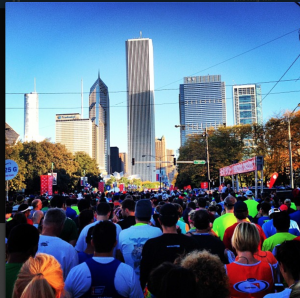Trans Marathon
Posted on November 15, 2013 | posted by: When this year started I had a set of goals I wanted to accomplish. Amongst them was running my first marathon and starting my Master’s Program. Both of which I’ve been able to pursue. However, I never imagined that my perception of the marathon would change so much through my education. I have been running for years but TransD has shifted my perception of races, what they mean to me as an individual, how they relate to a larger scale. There was a shift from seeing marathon running as simply hobby to in Johnson’s words a system with multiple agents, dynamically interacting in multiple ways, following local rules and oblivious to any higher-level instruction. (Johnson,19)
When this year started I had a set of goals I wanted to accomplish. Amongst them was running my first marathon and starting my Master’s Program. Both of which I’ve been able to pursue. However, I never imagined that my perception of the marathon would change so much through my education. I have been running for years but TransD has shifted my perception of races, what they mean to me as an individual, how they relate to a larger scale. There was a shift from seeing marathon running as simply hobby to in Johnson’s words a system with multiple agents, dynamically interacting in multiple ways, following local rules and oblivious to any higher-level instruction. (Johnson,19)
A group of 45,000 runners where brought together in the Chicago Marathon, each one of them following their own rules and dreams in their search for setting personal records. By doing so, they might also be engaged in a bigger cause like running for a charity or it might be something more personal as honoring a lost loved one. Whichever reason a runner might have to endure the 26.2 miles that a marathon represents there’s usually an inner dialogue to motivate oneself. The character of the marathon brings together the runners with an awesome cheering crowd. An innovative and creative group of individuals that use a combination of posters, phrases to inspire the runners. They are following their own motivations, it might be cheering a loved one, having fun or simply feeling as they are part of the marathon. It now becomes clear that patterns start to emerge from simple interactions among runners and people that cheer. This becomes more complex when we think that all of this is possible because of a group of organizers that set simple rules that allow this interactions to happen. There are time limits, a route, hydration and aid stations, corrals defined by expected finish times, and security check points. Other than that every runner is following their own local goals rules while interacting with others that share a general goal.
Given that there is a large number of runners, people cheering and volunteers there is a high number of interactions. At the same time the thousands are cheering with funny or motivational posters and phrases that from conversations with my friends made them enjoy their race even more. It’s this amount of encounters that make the marathon so different from running a regular race. Knowledge, motivation and goals are being shared. Everyone is solving and facing their own personal struggles but with out realizing. As Johnson suggests the is encounters allow for new information to be shared from which individuals can acquire more knowledge.
Once I was able to step back I connected my training to a larger system. This individual sport led to a collective activity which enabled as Johnson suggest a complex behavior to tickle up. Individuals goals and hobbies make possible an event in which city gains large economical revenues, changes of cultural interactions are high and where there are unusual levels of empathy. Everyone is encouraging everyone to follow their ambitions, not to give up. It’s a collaborative effort in which everyone by pursuing their own goals are helping their neighboring runners pursue their own.
I’ve been inspired to the way in which a marathon provides a general framework/context in which everyone is pursuing there own goals. There are general and abstract rules that are set by designers of the event. A marathon creates a scenario in which each individual envisions a future for themselves by establishing their own parameters. Design projects could learn from the spirit of the marathon. It’s not about telling people what to do or how to do. People are able to find ways and means to achieve their needs if they are given a designed scenario with general rules to follow but inspires them enough to give the best they can give. Design just like the marathon can propose an event a situation in which people are inspired to change behaviors to achieve their goals.